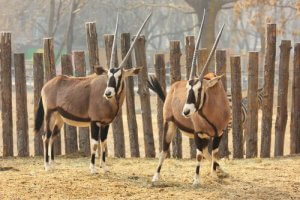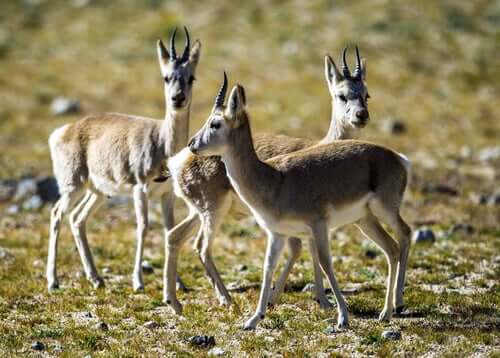All About The Tibetan Antelope

Also known as the chiru, the Tibetan antelope is a mammal that lives in Asia. It’s quite famous there and was even chosen as a mascot for the 2008 Beijing Olympics.
What are they like and where are they found?
This antelope is found across the Tibetan plateau on steppes ranging between 10000 and 18000 feet above sea level. They like open areas with not much vegetation and can also be found in northern India and certain parts of China and Nepal.
Its scientific name is Pantholops hodgsonii and it belongs to the antelope family and is medium in size. Males can reach nearly 3 feet in height and weigh about 90 pounds, whilst the females are 4 inches shorter and around 30 pounds lighter.
This species has pronounced sexual dimorphism, which means that the males and females look very different from each other. The males have black horns and lines on their legs. Their horns are curved backward and can reach 2 feet in length. Unlike with goats, these antlers don’t grow throughout their lives. The males use their horns to demonstrate power during the mating season.
Both sexes have reddish-brown fur with a thick, white woolly belly. Their faces are almost completely black, and, for males, this becomes more marked during the winter because their body gets paler.
Behavior and reproduction of the Tibetan antelope
The Tibetan antelope’s diet is based on grasslands, herbs, and reeds. In winter, they have to dig in the snow to get food because it’s quite scarce.

It’s a gregarious animal, which means that they move in herds of hundreds of antelope when traveling in search of better grazing pastures. However, they generally form smaller groups of about 20 individuals.
They’re shy animals but are also very fast. When chased by a predator, such as a lynx, wolf, snow leopard, or red fox, they can reach speeds of up to 70 kph.
The females can walk up to 300 kilometers per year to give birth, moving away from the rest of the group and the males. Then, they rejoin the herd at the end of autumn.
The mating season takes place from November to December. Each male forms a group of about 12 females maximum, although four is a more usual number. He is then responsible for expelling the other males through certain “exhibitions” using his head.
As a last resort, the males use their horns to demonstrate their power, for example, when another male is too insistent and stays near the group.
Females give birth to just one calf per litter. Since pregnancy lasts about six months, childbirth takes place between June and July. The calves can get up on all four legs just 15 minutes after birth and stay with their mother for a year (males) or a year and a half (females).

Once they are two or three years old, they reach sexual maturity. Although it’s not clear how long they can live for, estimates suggest that they can live for up to ten years.
The Tibetan antelope’s current situation
The ‘elf of the highlands’, as it’s affectionately known as to the local population, is a protected species in China and there are even three natural reserves that exist to preserve it.
Their numbers declined in the 90s due to a lack of food and poaching (antelope wool is highly-valued for shelter in the harsh winter). As a result, they need to hide themselves from humans more and more.
For this reason, the Chinese government has taken action and, thanks to the help of volunteers, the Tibetan antelope population is gradually increasing. The species is now no longer in danger of extinction and has had its status upgraded to ‘Near Threatened’.
Also known as the chiru, the Tibetan antelope is a mammal that lives in Asia. It’s quite famous there and was even chosen as a mascot for the 2008 Beijing Olympics.
What are they like and where are they found?
This antelope is found across the Tibetan plateau on steppes ranging between 10000 and 18000 feet above sea level. They like open areas with not much vegetation and can also be found in northern India and certain parts of China and Nepal.
Its scientific name is Pantholops hodgsonii and it belongs to the antelope family and is medium in size. Males can reach nearly 3 feet in height and weigh about 90 pounds, whilst the females are 4 inches shorter and around 30 pounds lighter.
This species has pronounced sexual dimorphism, which means that the males and females look very different from each other. The males have black horns and lines on their legs. Their horns are curved backward and can reach 2 feet in length. Unlike with goats, these antlers don’t grow throughout their lives. The males use their horns to demonstrate power during the mating season.
Both sexes have reddish-brown fur with a thick, white woolly belly. Their faces are almost completely black, and, for males, this becomes more marked during the winter because their body gets paler.
Behavior and reproduction of the Tibetan antelope
The Tibetan antelope’s diet is based on grasslands, herbs, and reeds. In winter, they have to dig in the snow to get food because it’s quite scarce.

It’s a gregarious animal, which means that they move in herds of hundreds of antelope when traveling in search of better grazing pastures. However, they generally form smaller groups of about 20 individuals.
They’re shy animals but are also very fast. When chased by a predator, such as a lynx, wolf, snow leopard, or red fox, they can reach speeds of up to 70 kph.
The females can walk up to 300 kilometers per year to give birth, moving away from the rest of the group and the males. Then, they rejoin the herd at the end of autumn.
The mating season takes place from November to December. Each male forms a group of about 12 females maximum, although four is a more usual number. He is then responsible for expelling the other males through certain “exhibitions” using his head.
As a last resort, the males use their horns to demonstrate their power, for example, when another male is too insistent and stays near the group.
Females give birth to just one calf per litter. Since pregnancy lasts about six months, childbirth takes place between June and July. The calves can get up on all four legs just 15 minutes after birth and stay with their mother for a year (males) or a year and a half (females).

Once they are two or three years old, they reach sexual maturity. Although it’s not clear how long they can live for, estimates suggest that they can live for up to ten years.
The Tibetan antelope’s current situation
The ‘elf of the highlands’, as it’s affectionately known as to the local population, is a protected species in China and there are even three natural reserves that exist to preserve it.
Their numbers declined in the 90s due to a lack of food and poaching (antelope wool is highly-valued for shelter in the harsh winter). As a result, they need to hide themselves from humans more and more.
For this reason, the Chinese government has taken action and, thanks to the help of volunteers, the Tibetan antelope population is gradually increasing. The species is now no longer in danger of extinction and has had its status upgraded to ‘Near Threatened’.
All cited sources were thoroughly reviewed by our team to ensure their quality, reliability, currency, and validity. The bibliography of this article was considered reliable and of academic or scientific accuracy.
- Leslie, D. M., & Schaller, G. B. (2008). Pantholops Hodgsonii (Artiodactyla: Bovidae). Mammalian Species. https://doi.org/10.1644/817.1
This text is provided for informational purposes only and does not replace consultation with a professional. If in doubt, consult your specialist.








